You are here: Books --> Effective Onscreen Editing 4th edition --> Word 2016 Chapter 5: Using Revision Tracking
Vous êtes ici : Livres --> Effective Onscreen Editing 4th edition --> Word 2016 Chapter 5: Using Revision Tracking
Chapter 5: Using Revision Tracking
“Elinor agreed to it all, for she did not think he deserved the compliment of rational opposition.”—Jane Austen, Sense and Sensibility
Software and reference links for all versions of Word
This Web page contains instructions on the following subjects:
Comparing and combining documents
Editor name changes to "Author" (anonymous reviews)
Explanation of icons in the Ribbon's review tab
Highlighter marker tool
Reviewing pane
Show Markup and Show for Review menus
Side-by-side display
Styles palette
Track changes options
Comparing and combining documents
Word lets you compare documents or combine multiple documents that contain tracked changes, then display the results in a single document using its revision tracking tools. To access these tools, open the "Tools" menu, select "Track Changes", and then select "Compare Documents":
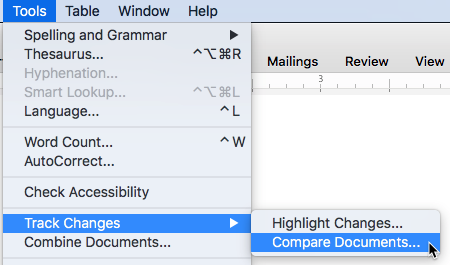
Word now lets you choose which two documents to compare and how to compare them:
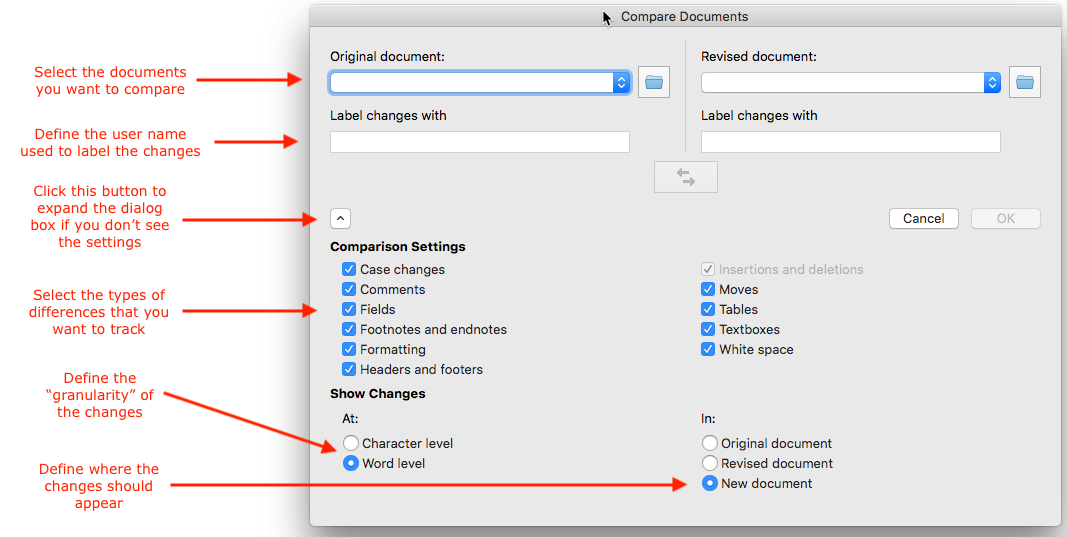
The "user name" that will be used to label the changes will typically be the name of the person (e.g., the editor) who is creating the summary document. The "granularity" of the changes represents whether fixing a simple typo will show individual changed letters ("Character level") or the entire corrected word ("Word level").
Word 2016 for Mac no longer offers a single tool to merge the revisions from multiple reviewers. To accomplish this, you will need to use the "Compare Documents" feature multiple times (once for each document that you want to merge into the final document).
Editor name changes to "Author" (anonymous reviews)
Word 2016 lets you remove your personal information from a document when you save it, which is useful if (for example) you need to do an anonymous review of a document. To do so, select the Ribbon's "Review" tab and click the "Protect Document" icon:

To remove your personal information from the document, while retaining your tracked changes, select the checkbox labeled "Remove personal information from the file on save":
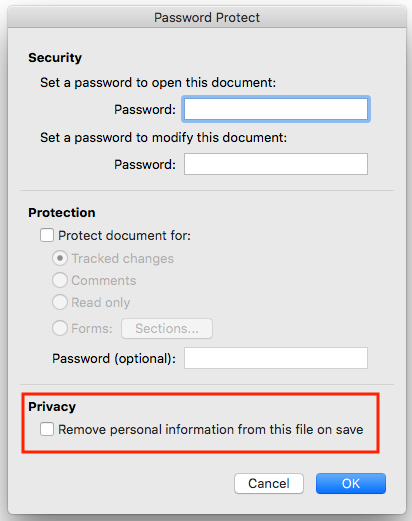
Word will continue tracking all changes as being made by the user name you specified when you customized Word (e.g., in my case, by "Geoff Hart"). However, as soon as you save the file, all those changes will be tracked as being made by "Author". This feature remains selected when you close a file at the end of the day, so when you reopen the file for editing, Word will continue to remove your user information. The only way to easily reapply the correct editor name to the changes is to use the Compare Documents feature illustrated earlier in this Web page and described in the book. To stop Word from removing your name information for subsequent edits, deselect the checkbox labeled "Remove personal information from the file on save".
If this option is unavailable, something else is causing the problem. Check Appendix III for possible solutions.
Explanation of icons in the Ribbon's review tab
The Ribbon's Review tab is where you control all of Word's revision tracking features. Here's a summary of the functions of the key parts of the tab:

More details are provided in the book and elsewhere on this page.
Highlighter marker tool
The highlighter marker lets you apply a highlight color to selected text or remove it from text. To access the tool, select the Ribbon's "Home" tab:

To apply or remove a color, select the text and then open the menu beside this icon. Click "No Color" to remove an existing color, or a color swatch to apply a color:
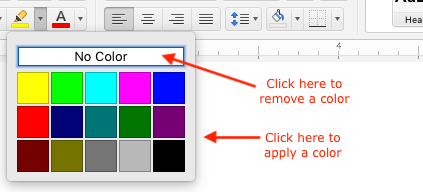
Reviewing pane
If you prefer to show your edits in a separate pane (a sub-window attached to the main document window), the "Reviewing Pane" menu lets you display that pane vertically, to the left of the document. Select the Ribbon's "Review" tab, then click the "Reviewing Pane" icon:

Show Markup and Show for Review menus
In addition to changing the format and color of tracked changes, Word lets you decide whether or not to show your changes, and which categories of changes to display at a given time. First, select the Ribbon's "Review" tab, then open the "Show for Review" menu:

Unfortunately, Microsoft took what used to be a clear and straightforward terminology, and changed it to something incomprehensible: "Simple Markup" shows the text that results from your changes, with vertical revision lines in the margin if you've set the revision tracking preferences to show those lines. "All Markup" shows the detailed changes that produced the simple markup. "No Markup" shows the final version of the document if the author accepts all of your changes. "Original" shows the original unedited manuscript.
What you actually see when you select these options depends on which changes you choose to show. This is achieved under the "Markup Options" menu:

Here, for example, I have chosen to show only comments, insertions and deletions, and format changes. The "Balloons" menu lets you further specify how to use balloons in the right margin to show your changes, and the "Reviewers" menu lets you choose which reviewer's comments should be displayed.
Note that even if you can't see the tracked changes, they will still be present in the file. You just won't be able to see them unless you choose a combination of options that reveals those changes.
Side-by-side display with synchronous scrolling
Unlike Word 2016 for Windows, Word 2016 for the Macintosh cannot automatically display two documents side by side to facilitate comparisons. To accomplish this, you must manually resize and reposition the windows that contain the documents. The Mac version also cannot scroll two windows simultaneously, so again, you'll need to do this manually.
Styles palette
To display the Styles palette, select the Ribbon's "View" tab, and then click the "Styles Pane" icon at the right end of the tab:

The Styles palette provides access to all properties of your styles and how they are displayed:
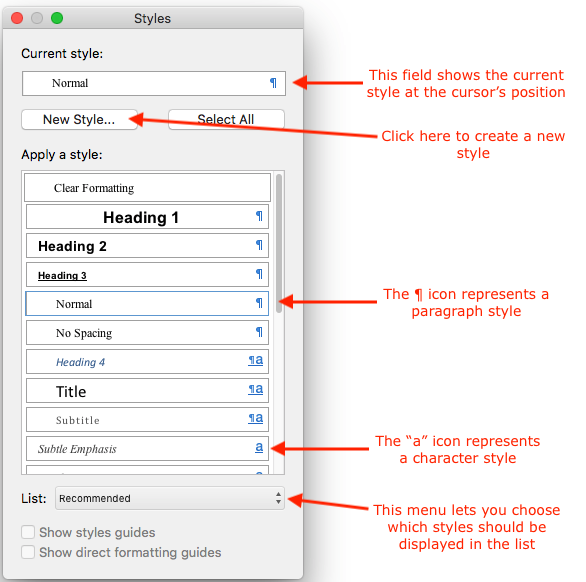
The "List" menu lets you display "Recommended styles" (Microsoft's odd choices), "Styles in use" (only the ones you're actually using), "In current document" (only styles that exist in the current document), and "All styles" (unusually, this means what it actually says):
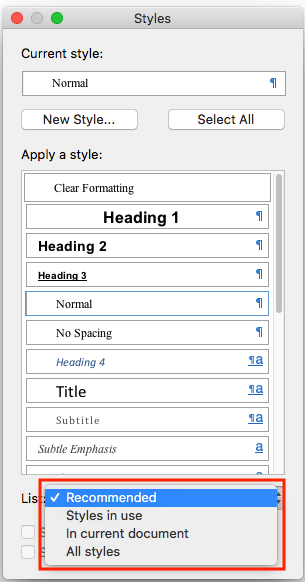
To modify a style's properties, move the cursor over the ¶ or a symbol that represents (respectively) paragraph and character styles to reveal a hidden menu. Open the menu to (for example) let you modify the properties of a style:
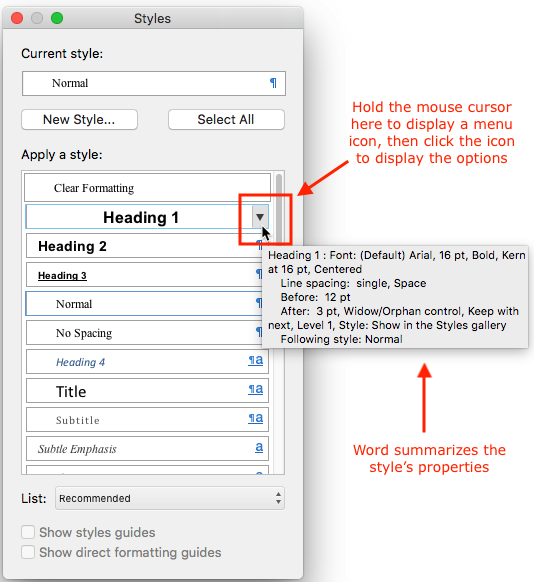
To change the font and other properties, click the little triangle to open the menu and then select "Modify Style".
Track changes options
To access the options for revision tracking, open the Word menu and select "Preferences". Click the "Track Changes" icon:
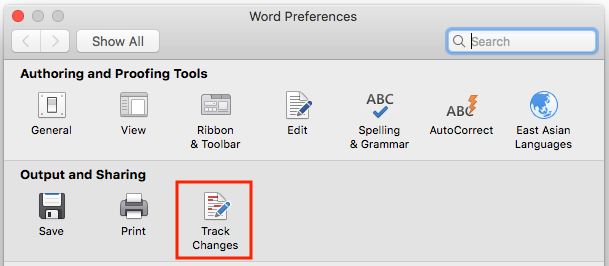
You can also access the options from the "Markup Optons" menu:
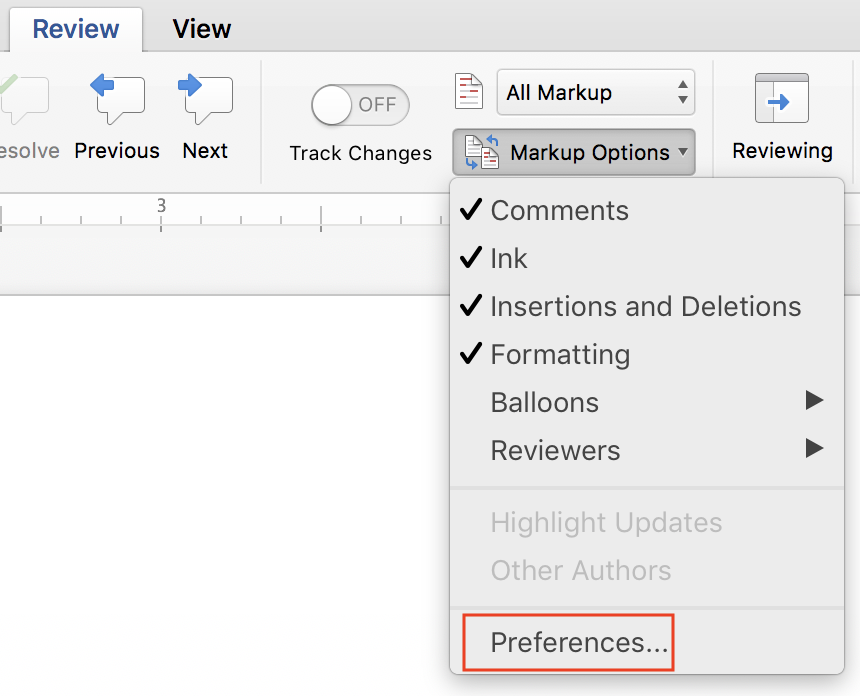
In the "Track Changes" control panel, you can now define the format and color of all tracked changes. Word displays the effects of these changes in a small rectangle at the right side of the dialog box:

©2004–2025 Geoffrey Hart. All rights reserved.












